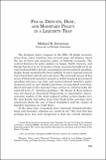Artículo
Fiscal deficits debt and monetary policy in a liquidity trap
Fecha
2011Resumen
The dramatic policy response to the 2008-09 global economic crisis from many countries has revived some old debates about the use of fiscal and monetary policy in fighting recessions. The central dilemma for policy-makers in Japan North America and Europe has been to try to counter a large recession brought on by an unprecedented fall in private consumption and investment spending despite being constrained by their inability to lower nominal interest rates below their current near-zero level. The end result was an ad hoc series of fiscal and monetary measures: deficit-financed government spending increases tax cuts and unconventional monetary policy measures such as open market purchases on long-dated securities direct increases in the monetary base and so on. Coming under the catch-all term of 'stimulus-packages' the design of these policies was not based on theoretical frameworks or quantitative macroeconomic models of the kind explored within central banks over the past decade but rather arose from 'back-of-the-envelope' style arguments about the size of fiscal multipliers and the impact of liquidity injections on credit flows.
Colecciones
Descargar


